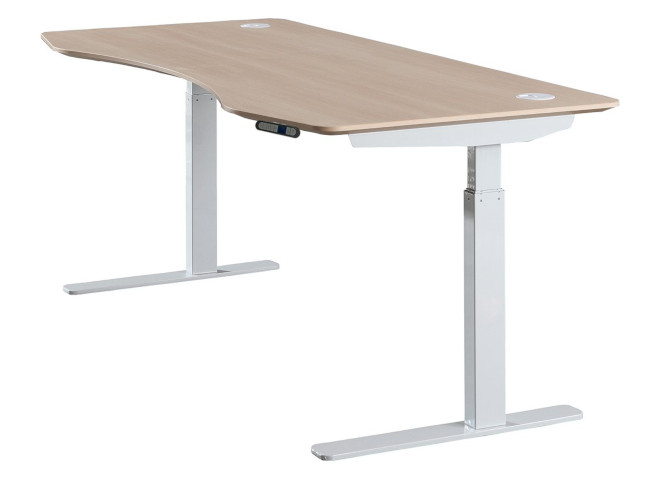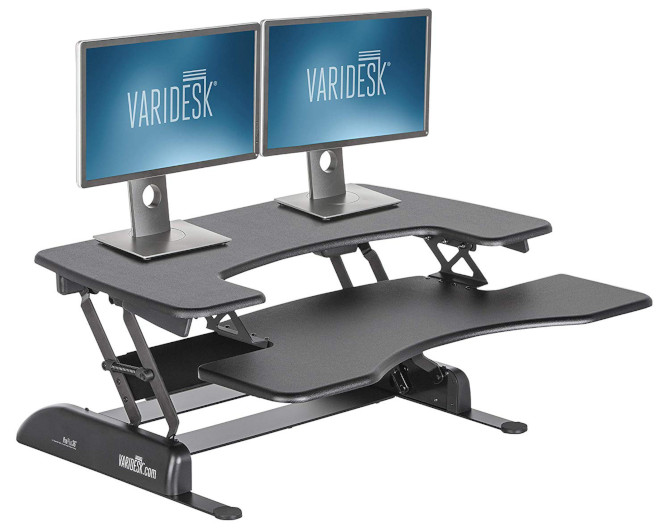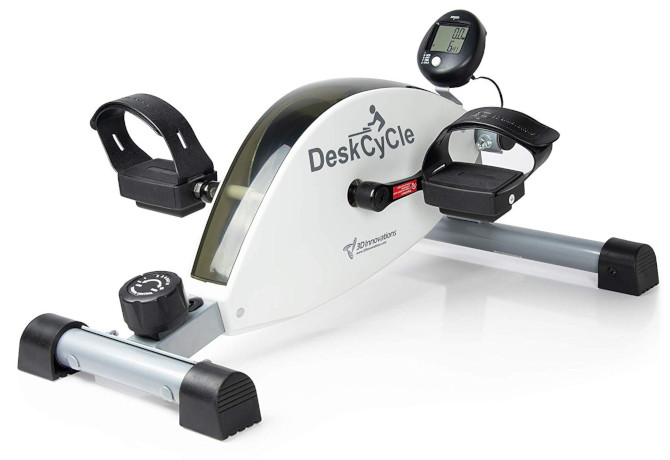Sitting all day is bad for you, and that's bad news if you work on a computer all day every day like I do. The solution is to get up and be active for at least 30 minutes per day, but for some of us, that just isn't possible—or, for some of us, we're too lazy to make that happen. Guilty as charged.
Another option, which is nowhere near as good as actually getting up and being active but still better than sitting down all day, is to switch to an adjustable standing desk setup that allows you to easily transform your workstation from one where you sit to one where you stand.
That's the route I took, and I kind of wish I hadn't.
Let's Be Clear: Adjustable Standing Desks Do Work
First, I want to make a small distinction:
A height-adjustable desk is a full dedicated desk that has a built-in feature that lets you adjust its height, whether manually or using an electronic button on the desk's underside. The entire desktop moves up and down.
An adjustable standing desk is an accessory that you place on top of a normal, non-adjustable desk. The accessory itself can have its height adjusted, so by putting your monitors and keyboards and mice on it, it effectively serves the same purpose as a height-adjustable desk.
Both are very good, and they both do exactly what they claim to do: make it possible for you to move your entire workstation up and down as necessary, allowing you to work while sitting or standing. The high-quality ones either have intricate spring-loaded mechanisms or electronic button controls that make adjustments dead simple and effortless.

And they are better for your health—if you use them correctly. The ideal method is to switch between sitting and standing every thirty minutes, which forces you to move and change positions. It's not the standing itself that's healthy; it's being stationary that kills you. And for this, desks that can change height are very useful.
So why do I regret my adjustable standing desk? Well, it's not the switching between sitting and standing that I don't like. That part is great! It's all the other minor issues that I failed to foresee—and while each issue is relatively minor, they all add up for an experience that's downright uncomfortable.
Why I Regret My Adjustable Standing Desk
Having spent $450 on my Varidesk Pro Plus 36, I was initially blown away by how useful it was, but my excitement has faded because I think I paid too much for what I got. My regret boils down to three main reasons:
1. Desk clutter gets in the way. My desk is a mess, and there's all kinds of stuff strewn about at any given time: peripherals, headphones, Post-It pads, computer accessories and adapters, external data drives, power banks, my coffee mug, my Oculus Quest... They get in the way whenever I need to switch modes, and sometimes even get caught in the mechanisms. It's my fault for not being organized, but it's a real (and common) problem.
2. Bad positions for monitors and laptops. With my iMac on my adjustable standing desk, it sits too high when I'm in sitting mode—and that has led me to eye fatigue, headaches, and shoulder pain. When I switch to standing mode, the iMac is the perfect height—but then my laptop is way too low, resulting in neck pain and wrist pain. A bit of a conundrum, isn't it?

3. Standing causes different kinds of pain. Whereas sitting has its own set of posture-related pain, standing introduces a bunch of new ones: upper back fatigue, sore butt, sore knees, and sore feet. Many standing desk users need to wear shoes with special insoles to manage foot pain. And there's also reportedly an increased risk of varicose veins if you stand in one position for too long.
Moral of the story? Well, Issues #1 and #2 could probably be solved by using a height-adjustable desk rather than an adjustable standing desk. I should have invested in one from the start instead of hoping that this option would work out for me. But Issue #3 would still be around for that, too.
At the end of the day, while I acknowledge that adjustable standing desks have proven useful for lots of office workers, it isn't right for me. I've reverted back to sitting in an office chair all day long, and I'm happy to say that I'm now happier and healthier than ever before—and that's because I've made some other changes beyond the adjustable standing desk that have had more profound effects on my health and wellness.
What Other Health-Conscious Options Are There?
Exercise. There's really no way around it. Computer-related posture problems—whether sitting or standing—all stem from weak muscles and poor flexibility. You have to strengthen your muscles if you want them to keep you upright all day without going sore. Don't have time to hit the gym? Neither do I! I do exercises right at my desk, in five-minute bursts whenever I can. Every little bit helps.

Desk bicycle. If I could go back in time and change my decision, I would've gotten the DeskCycle Desk Exercise Bike, which sits under the desk and lets you pedal while you work. With its wide resistance range and quiet operation, it does what standing desks don't: get you moving.
